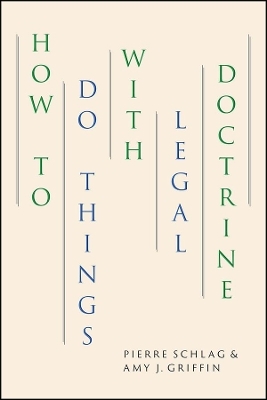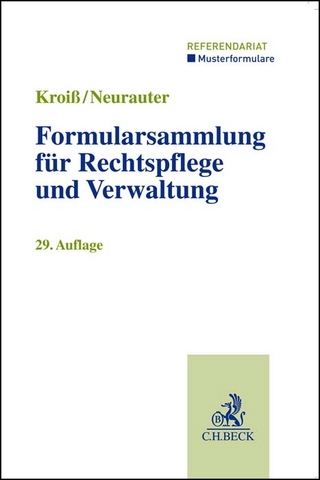
How to Do Things with Legal Doctrine
University of Chicago Press (Verlag)
978-0-226-72624-3 (ISBN)
Pierre Schlag is distinguished professor at the University of Colorado and the Byron R. White Professor at Colorado Law. His books include The Enchantment of Reason and Laying Down the Law. Amy J. Griffin professor of legal writing and the associate dean for instructional development at Colorado Law.
Introduction
Chapter One: What Is Doctrine? I. The Big PictureA. Artifacts
B. Sources of Law
C. Functions1. Structuration
2. Defusing, Resolving, or Extinguishing Conflict
3. Correction
4. Realization of the Legal System
5. ReflexivityD. Legal Elements 1. Legal Persons
2. Entitlements and Disablements
3. Attribution Rules
4. Transfer Mechanisms
5. Interests/Harms
6. RemediesII. DoctrineA. The Characteristics of Doctrine
B. The Structured Elasticity of DoctrineIII. The Itinerary
Chapter Two: Frames and Framing I. Entry-Framing
II. Broad vs. Narrow Time Frames
III. Segmented vs. Continuous Transactions
IV. Action vs. Omission
V. Level of Abstraction
VI. The Theater Metaphor
VII. Exit-Framing
Chapter Three: Baselines I. Baseline Selection ProblemsA. Classic Baselines
B. Variations within a Single Baseline1. Level of Abstraction
2. Individualization
3. MultiplicityII. Baseline Neutrality ProblemsA. Failed Neutrality
B. Denial and EvasionIII. Baseline Collapse Problems
IV. Summary
Chapter Four: The Legal Distinction I. What Do Legal Distinctions Do?
II. Three Criteria for “Sound” Legal DistinctionsA. Conceptual Intelligibility
B. Practicality
C. Normative AppealIII. The Trade-Offs among the Three Criteria
IV. The Classic Flaws and Why They MatterA. The Classic Flaws1. Overbreadth
2. Underbreadth
3. Overlap
4. Discontinuity
5. False Dichotomy
6. Incoherence
7. VaguenessB. Why the Classic Flaws Matter: From Form to Substance1. Waste
2. Fairness/Equality
3. Subversion
4. Efficiency
5. Rule of LawVI. Crafting Legal Distinctions
VII. Where Do You Draw the Line?A. The Non-ideal World and the Inevitable Trade-Offs
B. Arbitrariness
C. Indivisibilities
D. Dynamic Fields
E. Problem Fields and Non-fields: Of Polycentricity and Flux
F. The Slippery SlopeVIII. The Fetishism of the Legal Distinction
Chapter Five: Rules and Standards I. Defining Rules and Standards
II. The Rules vs. Standards DialecticA. Deterrence
B. Delegation
C. Communication/Formalities/NoticeIII. The Substantialized Versions of the Dialectic
IV. The Limitations of the DialecticA. Of Vices and Virtues
B. The Polycentricity Challenge
C. The Epistemological TwistV. The Irreducibility of the Dialectic
Chapter Six: Resolving Regime Conflicts I. TechniquesA. Hierarchy
B. Sectorization
C. Policy Judgment
D. Balancing
E. Meta-quantification Approaches
F. Conflict Prevention Approaches
G. Referral/Deference/Denial
H. ChannelingII. Putting It TogetherA. Hybrids
B. Entailments
C. Summary
Chapter Seven: Interpretation I. The Interpretive Situation: Recurrent Tensions and ConflictsA. The “Legal” in the Legal Text
B. The Interpretive Contexts1. Fact-Rich
2. Institutionally Localized
3. Procedural Posture
4. Discernible Specific ConsequencesC. The Textual Feedback Loop
D. The Plurality of Contexts1. The Context of Application
2. The Authorial Context
3. The Addressee Context
4. The Functional Legal Context
5. Contexts GenerallyE. Fidelity to the Original Meaning
F. SummaryII. TextualismA. Individuation: What Is the Unit of Interpretation?
B. Intratextual Integrity
C. Intertextual IntegrityIII. PurposivismA. Multiple Purposes
B. Selection
C. The Structure of PurposeIV. Summary
Chapter Eight: Cluster Logic I. A Cautionary Note
II. The Structural Distinction Clusters
III. How the Clusters MatterA. The Clusters as Classic Options
B. Nuance: Substituting One Distinction or One Term for Another
C. Cluster Functions1. Function Tags for the Choice/Coercion Cluster
2. Function Tags for the Public/Private ClusterIV. Operationalizing the Clusters: InteractionA. Combining Clusters
B. The Theatrical MetaphorV. The Logic of DissociationA. Chaining: Running an Argument through Successive Clusters
B. Cluster AlliancesVI. Cluster Logic
Coda: The Topics of Doctrine
Acknowledgments
Notes
Index
| Erscheinungsdatum | 23.09.2020 |
|---|---|
| Zusatzinfo | 14 tables |
| Sprache | englisch |
| Maße | 152 x 229 mm |
| Gewicht | 286 g |
| Themenwelt | Recht / Steuern ► Allgemeines / Lexika |
| Recht / Steuern ► EU / Internationales Recht | |
| ISBN-10 | 0-226-72624-X / 022672624X |
| ISBN-13 | 978-0-226-72624-3 / 9780226726243 |
| Zustand | Neuware |
| Haben Sie eine Frage zum Produkt? |
aus dem Bereich


